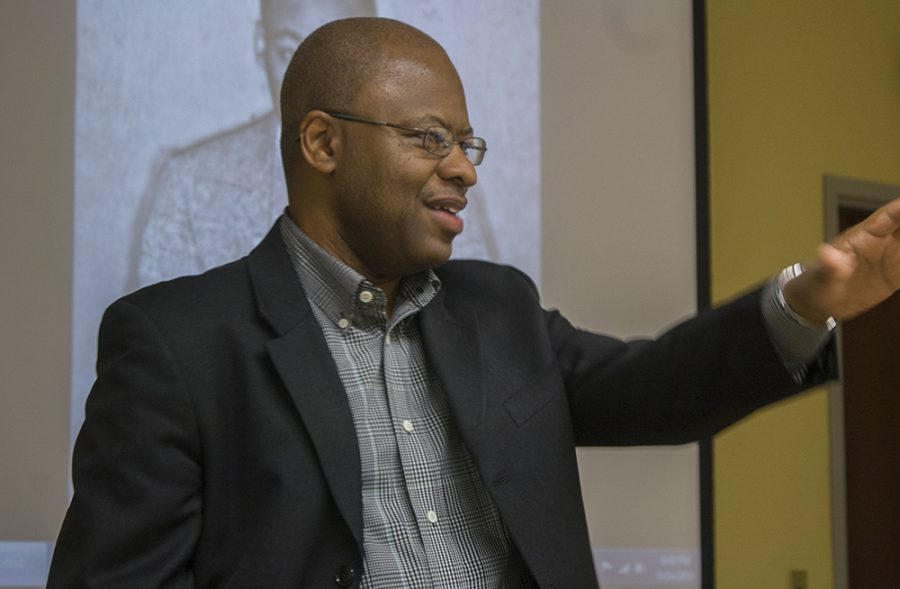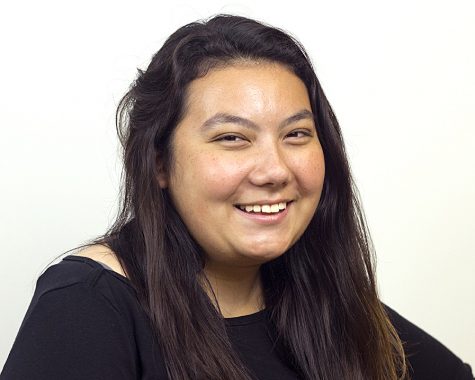Professor talks power of images
Cassie Buchman | The Daily Eastern News Political science professsor Kevin Anderson talks about the power of images, especially as they pertain to African-American politics and movements, at the Booth Library Wednesday.
September 14, 2016
The power of images and how they have affected African-American politics was the topic of the latest presentation at the Booth Library Wednesday.
The presentation was made by political science professor Kevin Anderson, and was a part of the exhibit, “For All the World to See: Visual Culture and the Struggle for Civil Rights.”
“African-American politics, without question, is American politics,” Anderson said. “Debates on questions of freedom, of equality, what constitutes justice, all of these arguments, all of these ideas are central ideas (that are) a part of American political thought.”
The images African-Americans used to fight for their equality showed the cruelty and inequality they faced in the U.S., while others showed a sense of independence and “pushback” against these oppressions, Anderson said.
To illustrate these images, Anderson showed historical pictures such as a slave with scars on his back from being beaten and a picture of a white teenager trying to strike a black attorney with the American flag.
He also showed a picture of a memorial sculpture made by Robert Gould Shaw that showed African-American soldiers fighting in the Civil War and portraits of four young girls who died when four Ku Klux Klan members bombed a church in Birmingham, Ala.
Though some think these images were meant to raise awareness of inequality, Anderson said they were also meant to create discussion and debate in the African-American community and push back against a racist institution.
“The understanding of cruelty has to embrace the idea that (what is happening) is cruel because this is a fellow human being,” Anderson said.
While showing the audience pictures of tragedies and violence, Anderson challenged the audience by asking which pictures defined the era and the country.
“Which part is definitive? Which one explains us in nauseating, complete, acceptable detail?” Anderson asked. “Is there one picture of you that you want everyone to see? And, by the way, is there a picture of you want no one to see?”
Anderson noted that when looking at pictures of public figures, such as Malcolm X and Martin Luther King Jr., what one sees is not the sum total of who they are as a person.
“The power of image is…if they are powerful enough, they provoke action from the other side,” Anderson said. “Good photographs (are) not going to provide answers, but it is going to provoke debate. And if you do that well, you might actually solve a problem or two.”
Karron Davis, a sophomore finance major, said the images Anderson showed were a good example of violence people kept trying to overcome.
“We’ve been struggling as a country to accept each other and all our colors,” Davis said. “We just need to come together and realize we’re one.”
Davis said the monuments Anderson presented stood out to him because they showed a group of people coming together for national equality.
Bree Johnson, a junior political science major, said the images Anderson used in his presentation stood out to her, especially as she had never seen some of them before.
The picture of the African-American attorney being attacked with the flag impacted her.
“How could that be acceptable right there on the street?” Johnson said. “It was very upsetting. Nobody wants to see something like that, especially as an African-American woman today.”
Johnson said while in some places racism has gotten better, in others it has not.
“It’s a reminder of what we need to do and how much better we need to get,” she said.
Cassie Buchman can be reached at 581-2812 or cjbuchman@eiu.edu





































































